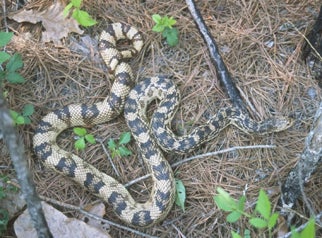SCIENTIFIC NAME:
Pituophis melanoleucus melanoleucus (Daudin)
OTHER NAMES:
Bull Snake, Common Pine Snake.
STATUS:
Rare and possibly threatened. Populations may be disjunct and very localized in Ridge and Valley, Appalachian Plateau, and Interior Plateau. HIGH CONSERVATION CONCERN.
DESCRIPTION:
A large (max. total length = 210.8 cm [83 in.]) snake with a moderately stout body. Head only slightly wider than neck; undivided anal scute; scales keeled except for some of lowermost rows, rostral scute (at tip of nose) enlarged, curving backward and ending in a point between and behind nostrils. Dorsal ground color white, cream, yellowish, or gray, with 25-31 dark blotches (including those on tail, which may form rings); anterior blotches somewhat poorly defined and blackish, becoming sharply defined and reddish toward tail. Belly glistening white with a row of distinct blackish spots down each side. May be mistaken for the gray rat snake, which it superficially resembles, but easily distinguished from the latter by the enlarged rostral scute and the undivided anal scale (divided in gray rat snake). Distinguished from the two other subspecies in the southeastern United States (Florida and black pine snakes) by color and distribution (see accounts for those subspecies) (Conant 1956, Martof et al. 1980, Mount 1975, Wright and Wright 1957).
DISTRIBUTION:
From New Jersey to South Carolina and Georgia westward to Kentucky, Tennessee, and Alabama. In Alabama, local in mountainous areas of the northern portion extending southward into the Coastal Plain of central Alabama to the valley of the Alabama River. In western Alabama, northern boundary of Black Belt believed to approximate southern limit of distribution. Intergrades between northern and Florida pine snakes have been found in central Alabama in Elmore and Crenshaw Counties (Godwin and Lahanas 1984, Mount 1975).
HABITAT:
Open areas with early successional vegetation, especially habitats subjected to occasional fire, preferred as are dry, forested, or partially forested areas where soil is fairly sandy or loose and gravelly. Closed-canopy forest avoided. In the Coastal Plain, habitats are usually dominated by longleaf pine-scrub oak forests. Above the Fall Line, dominant tree species include Virginia pine, longleaf pine, or a pine-hardwood mixture of the types typically associated with dry sites (Mount 1975).
LIFE HISTORY AND ECOLOGY:
Poorly known. In a recent unpublished telemetry study in Tennessee, spent much time underground in stump holes, and home ranges averaged 113 hectares (280 acres). Surface activities usually take place during early morning or late afternoon. When encountered in wild and prevented from escaping, usually assumes a threatening posture, vibrates tail, and emits loud hisses, holding the mouth partially open. If picked up, it may bite, but many individuals refrain from doing so. Oviparous, and lay clutches of large eggs in burrows or cavities in loose soil. Food items include small mammals, birds and their eggs, and, in the case of the young, lizards (Mount 1975, Wright and Wright 1957).
BASIS FOR STATUS CLASSIFICATION:
Little is known of any aspect of the natural history in Alabama. Few specimens have been recorded, and numbers appear to be dwindling.
Author:
James C. Godwin






